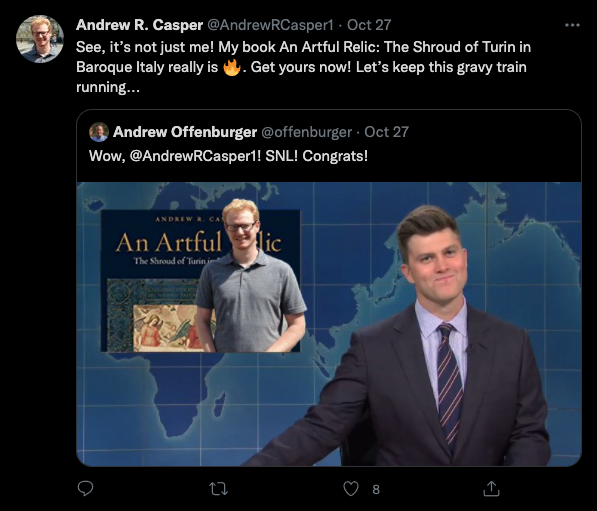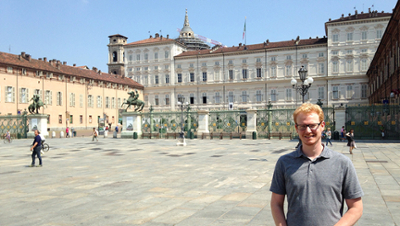
Appearing on SNL's Weekend Update (not really): a Q-and-A with Andrew Casper
Interview by Margo Kissell, university news and communications
Andrew Casper, associate professor of art history at Miami University, released his latest book, “An Artful Relic: The Shroud of Turin in Baroque Italy” (Pennsylvania State University Press) on Sept. 29. If you follow his Twitter feed, you’d think Casper appeared on Saturday Night Live’s “Weekend Update” recently — at least his photo and book cover did. Nope, just clever marketing on his part.
We caught up with Casper — a specialist of Renaissance and Baroque art of southern Europe — for this Q-and-A to learn more.
You nearly had us fooled with the image of co-anchor Colin Jost appearing to be talking about your new book on “Weekend Update.” Tell us how you came up with the idea for that funny meme or others that you’ve been tweeting.

This is the latest funny meme Andrew Casper and his colleague, Andrew Offenburger, have tweeted to promote Casper's new book online. Casper's Twitter handle is @AndrewRCasper1.
I wish I could say that this was a premeditated strategy with the goal and eventual outcome of publicizing my books. But to be perfectly honest, I’m not sure it was, on either count. Really, it’s a result of two things: First, I had never been on social media of any sort until a few months before my book was published, and it became clear that I should use Twitter to publicize my book more effectively. Second, I like to think of myself as somewhat of a humorous person (don’t ask my students what they think) and just thought it would be fun to make some funny tweets about my book. The SNL meme was generated by a colleague of mine (thank you, Andrew Offenburger), so I cannot take credit for it. But he’s clearly better at this than I am!
What impact have they had?
Again, I’m not sure it’s had much of an impact in terms of greater publicity or sales since most people who have seen, liked, and commented on my tweets have been the same people who have already known about and already purchased the book. But at the very least, I do hope that it shows that some of us academics are real people with senses of humor. Don’t get me wrong, my work is serious, and I have a serious dedication to my research. But especially these days, who doesn’t want something that makes them laugh or smile? If it gets someone new to buy my book, then that’s just an added bonus. (I’m fighting the urge to say that the only key to happiness is to buy my book … )
Your first book, “Art and the Religious Image in El Greco’s Italy” (Pennsylvania State University Press, 2014), examined the early career of painter Domenikos Theotokopoulos, widely known as “El Greco.” How did you market that book?
My first book was published in 2014 when I had literally no experience in, and even less interest, in social media. And so I relied entirely on my press, which does do a great job advertising to the main academic target audience. Whatever I did was a result of word of mouth — which is probably not very effective.
All kidding aside, tell us about your latest book. What made you want to write about the Shroud of Turin?

Andrew Casper standing in front of the Palazzo Reale in Turin, Italy (submitted photo).
When I entered academia, this had always been the book I wanted to write. For a variety of reasons though I had to write my first book on El Greco first because it derived from my Ph.D. dissertation. But my interest in the Shroud of Turin goes all the way back to when I was a kid. Even from a non-religious perspective, I had been fascinated by the idea of the Shroud as a religious object and this interest continued through college. When I got to grad school to study for my doctorate in Italian Renaissance and Baroque art history, it became clear that there was a real opportunity to make a meaningful contribution to the vast literature that exists on the Shroud. Whereas most attention focuses on the contentious issue of authenticity, relatively little work has been done by scholars to address how or why the Shroud of Turin emerged as such a prominent religious image in the late 1500s and 1600s. My book fills that gap, and does so without having to make a declaration about whether or not it is real.
For those who aspire to write books of their own, what advice would you give?
I can only speak about writing academic books, which are fundamentally different from many other genres. But I do think that everyone who aspires to write should realize that writing books is hard. It’s time consuming. And it is a craft that requires far more attention than what many might think. It might seem like people sit down to write a book and a few months later it is done. That’s certainly not how mine are written. My Shroud of Turin book took about a decade of research — many trips to Italy to uncover documents, to examine 17th century copies of the Shroud, etc. It sounds glamorous, but I worked really hard for a very long time! And so I always say that with writing, as many things, if it’s not hard, you’re probably doing it wrong.
Finally, what’s your favorite time to write and where? Set the scene for us.
If I can’t be in Italy, then my favorite place to write, by far, is Kofenya here in Oxford. I’ve always fed off of the energy and stimulation (caffeinated or otherwise) that a good college town coffee shop can provide, especially in the morning. I was awarded a yearlong research leave for the entire 2019 calendar year to complete the full manuscript, and I would say there was rarely a week where I didn’t spend the majority of my mornings at Kofenya sipping espressos. So really, I wrote this book right here in Oxford’s best coffee shop!
